Hi, I'm Anna Comet, a professional trail runner and a mother of two. One of my children is six years old, and the other is just a few days old.
For many years, we've been told that being active during pregnancy is not advisable. However, scientific evidence is showing that being active during pregnancy is actually very healthy for both the mother and the baby.
It's just common sense that during this time, training needs to be adapted and the health and safety of both the mother and the baby should come first. But if everything's healthy and within normal parameters, it's totally possible to train safely and healthily during these months.
If you're feeling unsure, it's always a good idea to reach out to a specialist who can help you create a personalized training plan that works for your unique situation. In this post, I'll share how we've approached training during my second pregnancy, trimester by trimester, to help you feel confident and supported on your fitness journey.
First Trimester
The first 12 weeks are so important! During this time, it's best to be extra careful with your training. These weeks are crucial because that's when the embryo attaches to the uterus. Unless there's a medical reason not to, it's generally safe to keep going with training. However, it's always good to keep a few things in mind:
• These are usually the weeks when we're all out of energy and feeling pretty rough. Sure, moving helps with a lot of these annoying symptoms, but it's not always easy to get up and go. It's important to listen to your body — it's got its own way of telling us what's up.
• During these weeks, it's a good idea to save some extra energy for the pregnancy itself. When it comes to working out, go easy on yourself and don't push yourself too hard. Enjoy the great outdoors, take some deep breaths, and do whatever makes you happy.
• Strength training is really interesting during the whole pregnancy, and especially during this trimester. You should avoid isometric exercises because they can increase pressure, which is not recommended.
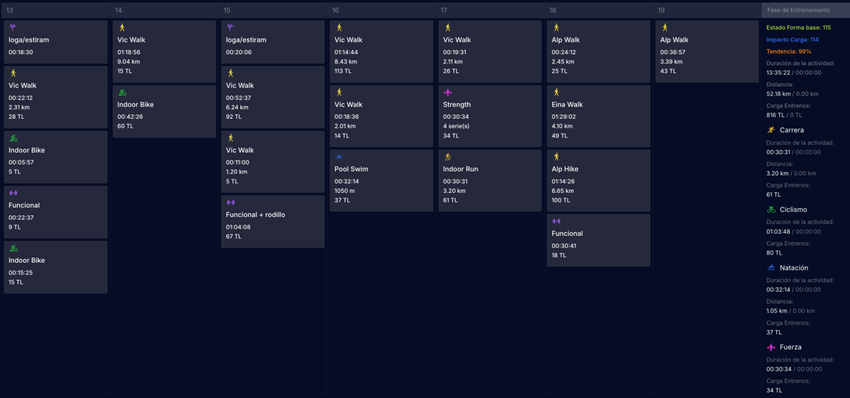
Anna's Training Calendar in May, during the first trimester
"According to sensations" would be a good summary to compile the training during these weeks.
Second Trimester
In general, energy returns. Suddenly, all that food that made you sick, you feel like eating again, you feel like moving again, your mood improves, etc. You are not aware of it, but under normal conditions, it's a few weeks to enjoy!
It is time to increase the training load again:
• Strength work is still key and can occupy an important portion of the training during this period: both the upper and lower body and, above all, we cannot forget the core area. It is one of the key areas to have a good delivery and to prepare for the postpartum period. Obviously, many exercises will have to be adapted as the body changes, especially the position of the pelvis, hips and back. We must ensure that the exercises do not cause back pain or associated problems. What I can assure you is that if we keep the core area (lower back, abdominals and buttocks) strong, back pain goes quite unnoticed. On an anecdotal level, around week 20 I had a terrible low back pain, which I thought would accompany me until the end of pregnancy. We treated it, changed the position of some exercises, and it disappeared completely and did not appear again!
• Joint mobility should be one of the "musts" during this period and until the end of pregnancy. Obviously, always with gentle and well-chosen movements - a specialist can help you a lot in this. Dedicating time to mobilizing the hip area is an ideal preparation for childbirth and, again, to have a better postpartum. In the end, most sportswomen are looking to get back to their routines as quickly as possible after childbirth, and both strength and mobility are key to this purpose.
• Proprioception (balance) is of great help in maintaining the body's balance. As the fetus gets bigger and becomes more and more like our future baby, it does not take into account what is in its way, it simply grows and makes its own space, while your body adapts as best it can. One of these adaptations is a change in the center of gravity, causing the loss of balance and body control. Good proprioception work helps us to stay much more stable, avoid falls and uncomfortable imbalances. I can assure you that I managed to run down mountain trails safely and fairly quickly until a few days before giving birth and without committing any recklessness.
• Aerobic work is predominant when it comes to resistance training. Even so, during the second trimester, we introduce one session per week of 5' to 8' sets at moderately high heart rates. Working in the aerobic power zone of the app, trying not to go more than 1% or 2% in the threshold zone.
If we put a little order to the workouts I’ve described, a typical week, during weeks 14/15 to 28 approximately, would be as follows:
- 3 general strength work sessions of about 45' each
- 3 mobility + proprioception + stretching sessions
- 5 sessions of resistance work distributed as follows:
- Walking - running in the mountains, looking to accumulate elevation gain and always with poles to increase the metabolic cost and to descend more safely. These sessions of between 90' and 120' at medium heart rates in the aerobic endurance zone with some peaks of aerobic power on the climbs.
- Flat runs at a comfortable but happy pace, with a predominance of the aerobic endurance zone from about 70' to 90'.
- I work on the elliptical for about 60' with series of 5' to 8' without reaching the threshold, but staying in the upper zone of aerobic power.
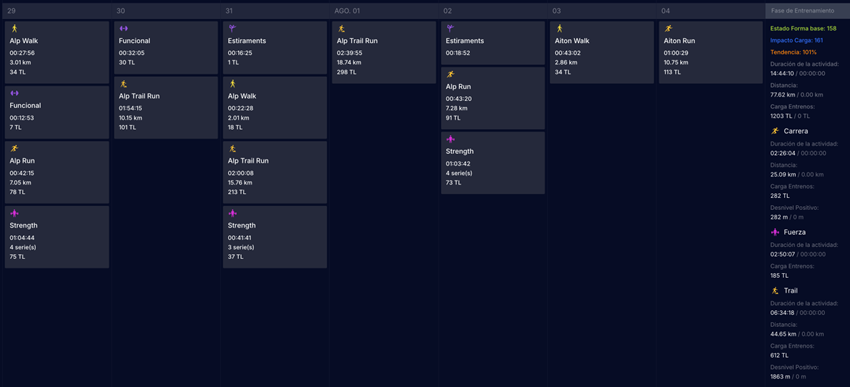
Anna's Training Calendar during August
Third Trimester
Unlike what I expected, the weeks from 30 to 39 (in my case that is when Lluc was born) were very prolific weeks. I thought I would notice a big drop in energy, heaviness, and little desire to continue with the workouts... but the work done so far was key to keep me very fit and, above all, with a very high level of energy. Something that in the last few weeks is very much appreciated!
A few notes on the training:
• We maintained 3 sessions of strength work, with special emphasis on the core, but without neglecting the rest of the body. Personally, I was still moving weights of between 5 and 10 kg and rubber bands of different intensities depending on the exercises.
• We continued with mobility and proprioception. I mistakenly thought that I would lose a lot of balance, comfort, and mobility. With the constant work, though, I have realized that I have not lost in these aspects, but rather have improved.
• As for the endurance work, the body has been asking me little by little to spend less time in the aerobic power zone. First, I noticed that reaching 8' was already too much. I reduced the minutes until I abandoned the specific training in this zone. On the other hand, I was able to lengthen the workouts in the aerobic endurance zone in a very comfortable and pleasant way, reaching 90' to 150' workouts both in ski mountaineering, walking - running in the mountains, as well as flat runs that I was able to maintain at a pace of 5'30''/km approximately until the day before the birth.
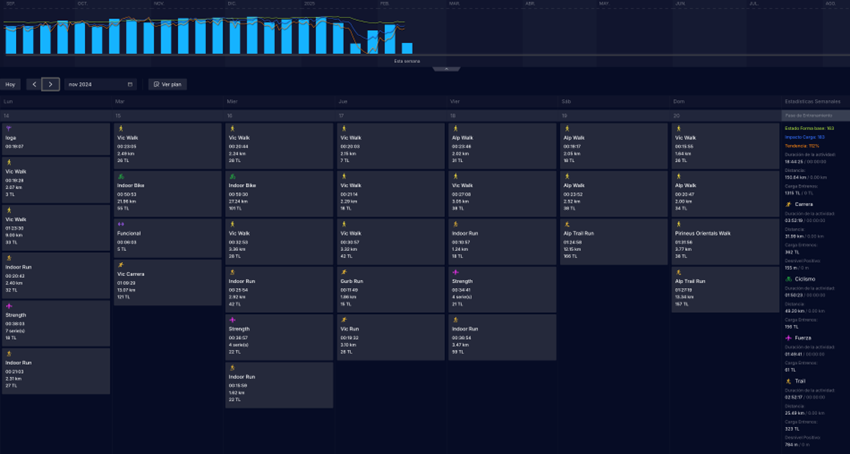
Anna's Training Calendar in November
During pregnancy, I have never worried about the pace, km or elevation gain. While I have gone out to train, what has commanded has been the sensations, which I have always sought to be pleasant. The result of some rhythms, accumulation of volume or elevation have been the result of a very constant work and very well directed by professionals throughout the pregnancy. I have always looked at the cadence, distance, and elevation in the app once the training is finished. I have been fascinated to see the ability of the body to stay strong and active if there is well-planned and consistent work and, of course, if the health of both the woman and the fetus accompany it.

Let's Analyze It!
If we focus on the different values on the graphics offered by the COROS Training Hub, we clearly observe the entire process over time. If we look at the Training Load graph during my first trimester: from mid-May to mid-July, we can clearly see that there is a drop in both load and fitness. This is normal and advisable. There’s typically a few weeks of "take it easy", but without stopping movement.
In the second trimester, which approximately went from the beginning of September to November, we can see a clear improvement - and although every day I have more belly, I can do it all!
Finally, if we look at the graphs in the last trimester, we can clearly see that we have been able to maintain both load and fitness even though the workouts have changed a bit, leaving aside the small contribution of intensity that we had in the previous period, but made up for by an increase in time.
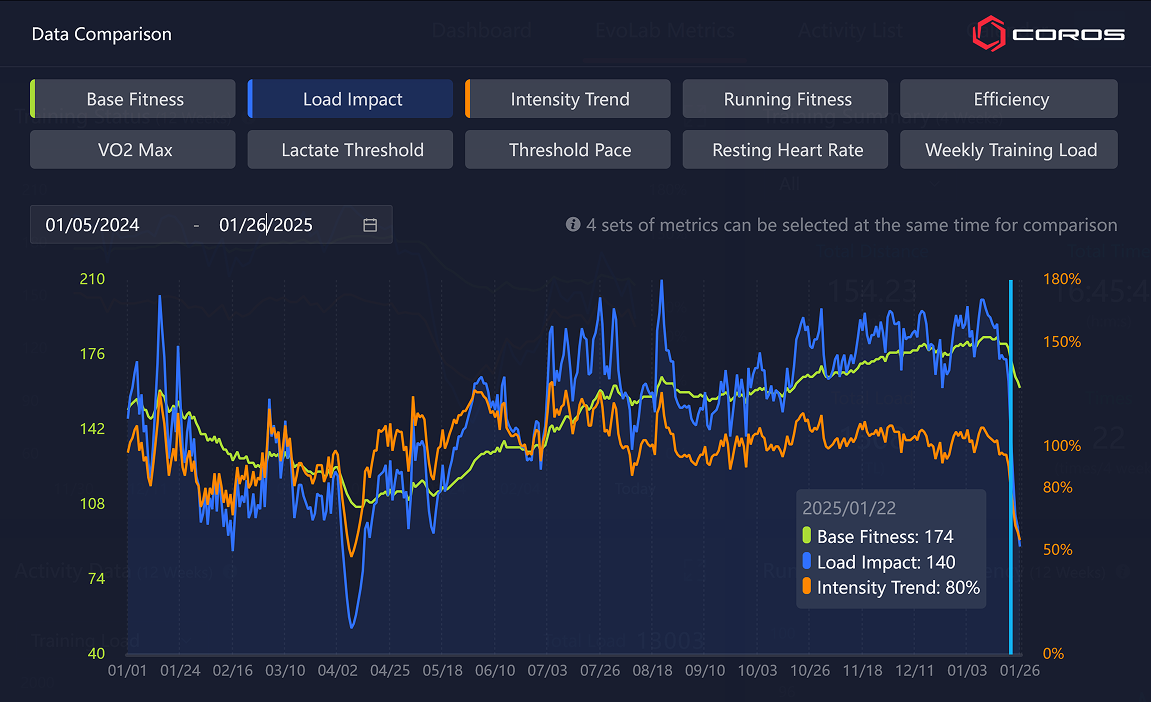
A topic also to take into account is the decrease in VO2Max, a normal thing due to the physiological adaptations caused by pregnancy. I moved from 50 in the beginning of pregnancy to 47 at the end.
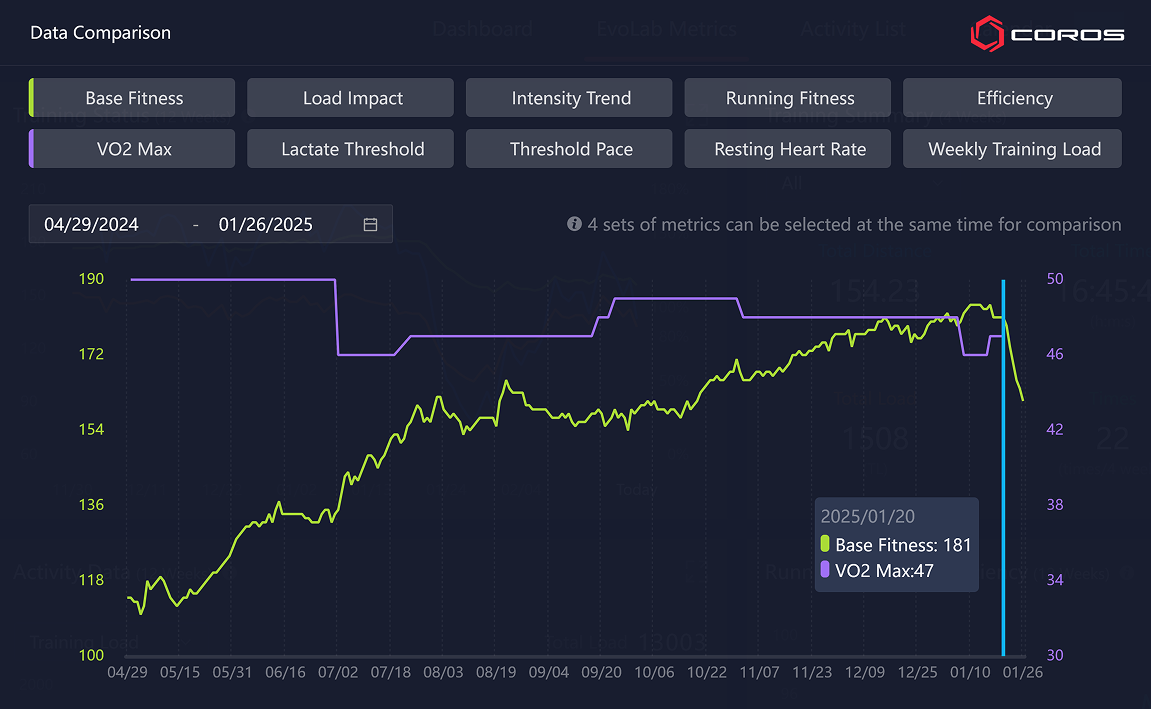
And another interesting point to highlight is the increase in resting heart rate (and also during training) as pregnancy has advanced - also normal due to physiological adaptations. I went from 46 to 64 BPM.
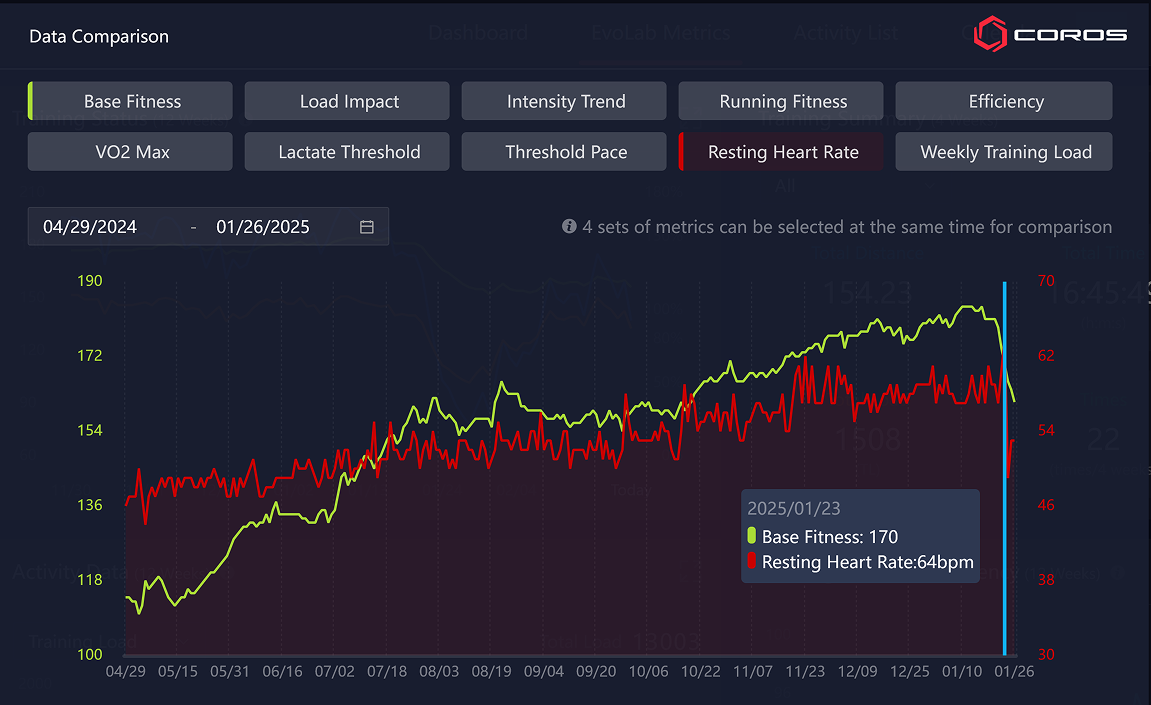
Simply, the body is wonderful!
/fit-in/0x18/coros-v2/images/common/logo_black.png)




